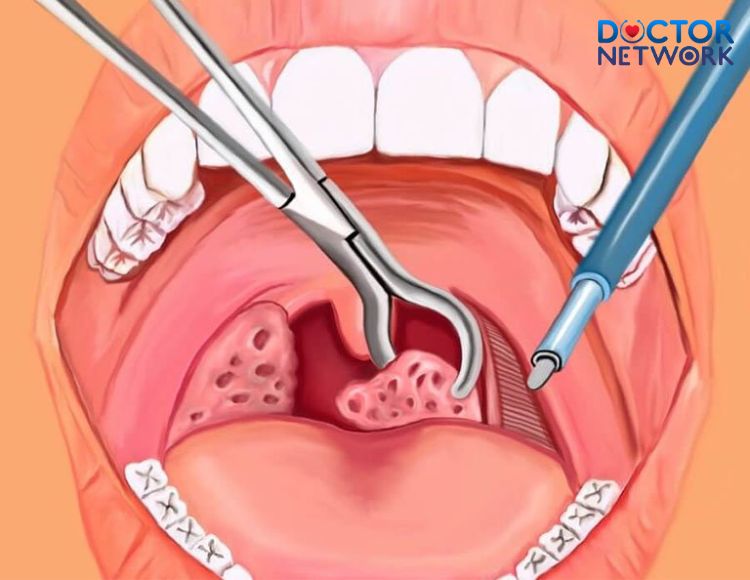Is tonsillectomy a painful procedure? This is a common question for many people considering this treatment method. This article will provide you with detailed and comprehensive information about tonsillectomy, from an overview of the tonsils, the surgical procedure, pain management strategies, to post-operative care considerations. It is hoped that after reading this article, you will have a clearer understanding of tonsillectomy and make informed decisions about your health.
Overview of Tonsils
Tonsils are two lymphoid masses located on either side of the throat, playing a crucial role in the body’s immune system. They act as a protective barrier, helping to prevent bacteria and viruses from entering the body through the respiratory tract. However, tonsils can sometimes become infected and swollen, causing discomfort and affecting health.

The tonsils are two masses of lymphatic tissue located on either side of the throat, playing an important role in the body’s immune system
What is Tonsillectomy?
Tonsillectomy is a surgical procedure to remove the tonsils. This procedure is usually recommended when tonsillitis becomes chronic, causing issues such as recurrent throat infections, sleep apnea, or difficulty swallowing. There are three common methods for tonsillectomy: using a scalpel, laser, or coblator. Each method has its own advantages and disadvantages, and the choice of method depends on individual circumstances, as advised by the doctor.
Does Tonsillectomy Hurt? – One of the common questions about tonsillectomy is whether it hurts. The answer is yes, tonsillectomy can cause throat pain, but the level of pain varies from person to person and depends on the surgical method, individual pain tolerance, and other factors. The pain typically starts after the anesthesia wears off and can last from a few days to a few weeks. However, doctors prescribe pain relievers and provide post-operative care instructions to minimize discomfort.

Tonsillectomy can cause a sore throat, but the level of pain varies from person to person and depends on the surgical method
Surgical Procedure of Tonsillectomy
Before surgery, patients undergo tests to assess overall health status and ensure safety during the procedure. Patients are instructed to fast as per the doctor’s recommendations. During the surgery, patients are either given general anesthesia or local anesthesia to minimize pain. The surgeon will remove the tonsils using one of the aforementioned methods, with the procedure usually lasting between 30 to 60 minutes. After surgery, patients are monitored in the hospital for a short period to ensure no complications arise. Doctors provide instructions on wound care, dietary restrictions, and rest to facilitate quick recovery.
Post-Operative Considerations
Post-operative dietary habits are crucial, with patients advised to consume soft, easy-to-swallow foods such as porridge, soup, and yogurt, while avoiding spicy, hot, or hard foods.
Drinking plenty of water also helps soothe the throat and prevent dehydration.
Sufficient rest is essential for prompt wound healing.
Patients should avoid strenuous activities and limit talking in the first few days after surgery.

Getting enough rest is important for a quick wound healing
Doctors prescribe pain relievers, antibiotics, and other medications to help patients manage pain, prevent infection, and support recovery. Patients need to strictly follow the doctor’s instructions regarding dosage and duration of medication. Follow-up appointments are scheduled to check the surgical site, evaluate recovery progress, and address any patient concerns.
Common Questions About Is tonsillectomy a painful procedure?
Here are some common questions related to “Is tonsillectomy a painful procedure?“:
Does tonsillectomy hurt and how painful is it?
Tonsillectomy can cause throat pain, with varying levels of discomfort. The pain is often described as similar to severe throat inflammation, accompanied by difficulty swallowing, earache, or headache. Pain intensity typically decreases over a few days and resolves completely within 1-2 weeks.
How to reduce pain after tonsillectomy?
There are several ways to alleviate pain after tonsillectomy, including:
- Using pain relievers as prescribed by the doctor.
- Applying cold compresses to the throat.
- Consuming soft, easy-to-swallow foods and drinking plenty of water.
- Gargling with warm salt water.
- Avoiding strenuous activities and limiting talking.
Are there any complications after tonsillectomy?
Tonsillectomy is a safe procedure, but complications such as bleeding, infection, nausea, vomiting, or difficulty breathing may occur. However, these complications are rare and can be managed if detected and treated promptly.
Which is the best method for tonsillectomy?
Currently, there are three common methods for tonsillectomy: scalpel, laser, and coblator. Laser and coblator tonsillectomy methods are often less painful and have quicker recovery times compared to traditional scalpel methods, but they may be more expensive. It is advisable to discuss with your doctor to choose the most suitable method based on your health condition and needs.
When to Consider Tonsillectomy?
The decision to undergo tonsillectomy should be made after thorough examination and consultation with an otolaryngologist. The doctor will assess the condition of your tonsils, consider factors such as the frequency of tonsillitis, impact on quality of life, and other health factors to make an appropriate decision.
Scientific Evidence on “Is tonsillectomy a painful procedure?”
Here is some scientific evidence on “Does tonsillectomy hurt?”:
- A study by Windfuhr JP, Chen Y, et al. (2018) published in The Laryngoscope evaluated pain levels after tonsillectomy in children using the Wong-Baker FACES scale. The results showed that pain peaked on the second day post-surgery and gradually decreased within 7-10 days.
- A study by Orloff LA, et al. (2015) in the Otolaryngology–Head and Neck Surgery journal compared pain levels after tonsillectomy in adults and children. The results indicated that adults often experience higher levels of pain and longer recovery times compared to children.
- Age factor: A study by Mitchell RB, et al. (2005) in the International Journal of Pediatric Otorhinolaryngology showed that children under 10 years old generally experience lower pain levels and faster recovery times compared to older children and adults.
- Surgical method: The study by Windfuhr JP, et al. (2018) also indicated that laser or coblator tonsillectomy methods are often less painful compared to traditional scalpel methods.
Tonsillectomy is a safe and effective procedure for treating tonsil-related issues. While it can cause pain, the pain can be managed with pain relievers and proper care measures. If you are experiencing tonsil-related issues, consult a doctor for advice and appropriate treatment.”
This translation aims to convey the medical information accurately and clearly in English, adhering to a medical writing style.
References:
https://www.ncbi.nlm.nih.gov/pmc/articles/PMC3450533/
https://www.childrens.health.qld.gov.au/health-a-to-z/tonsillectomies
https://health.ucdavis.edu/children/patient-education/Pain-medication-management
Kiểm Duyệt Nội Dung
More than 10 years of marketing communications experience in the medical and health field.
Successfully deployed marketing communication activities, content development and social networking channels for hospital partners, clinics, doctors and medical professionals across the country.
More than 6 years of experience in organizing and producing leading prestigious medical programs in Vietnam, in collaboration with Ho Chi Minh City Television (HTV). Typical programs include Nhật Ký Blouse Trắng, Bác Sĩ Nói Gì, Alo Bác Sĩ Nghe, Nhật Ký Hạnh Phúc, Vui Khỏe Cùng Con, Bác Sỹ Mẹ, v.v.
Comprehensive cooperation with hundreds of hospitals and clinics, thousands of doctors and medical experts to join hands in building a medical content and service platform on the Doctor Network application.


























